
The University of Phoenix is paying a record $191 million to settle a complaint filed by the Federal Trade Commission accusing the for-profit university of using deceptive ads to lure students with the promise of future job opportunities with large companies such as AT&T, Adobe, Twitter, Microsoft and Yahoo. The settlement includes a plan to cancel $141 million in student debts that are owed to the school by people who enrolled from October 2012 through the end of 2016 – the period in which the FTC says prospective students might have been duped. The remaining $50 million in the settlement will be paid in cash, which the FTC says “will be used for consumer redress.”
Court documents show the settlement gives the University of Phoenix and its parent company, Apollo Education Group, 15 business days to send an email and letter to eligible students, informing them that they’re covered by the agreement. The letters inform eligible former students that they no longer owe any money to University of Phoenix and their account balance will be cleared within 45 business days. The letter also states that the school has 55 business days to tell credit reporting agencies to delete the debt from students’ credit reports.
The FTC says the university wrongly suggested that it worked closely with high-profile companies to develop its courses and the school’s “Let’s Get to Work” ad campaign was one example of how it hyped connections with potential employers that did not exist. The University of Phoenix successfully targeted minorities, military veterans, service members and their spouses for enrollment, the FTC says, calling the University of Phoenix “the largest recipient of Post-9/11 GI Bill benefits since the program’s inception.” As part of the deal, the university did not admit or deny any wrongdoing alleged in the federal complaint.
Andrew Smith, director of the FTC’s Bureau of Consumer Protection said in a statement that it’s the largest settlement the FTC has obtained against a for-profit school. Smith added, “Students making important decisions about their education need the facts, not fantasy job opportunities that do not exist.” In response to the FTC settlement, the University of Phoenix issued a fact sheet touting both its achievements and its commitments to improve. In it, the school says it devoted 17% of its total spending in the 2018 fiscal year to marketing costs. The fact sheet concludes with a section titled “We Are Committed To Responsible Marketing.”
The settlement affects students who were enrolled between October 2012 and December 2016 but does not apply to those who owe money from federal and private loans. William Hubbard, a spokesman for Student Veterans of America, said the case “heavily underscores that questionable practices to aggressively recruit students are not acceptable,” but added the debt covered represented “a small piece of the pie.” “Ultimately private loans, those don’t fall under the debt cancellation rules,” he said. “If you’re a student that is paying for costs out of pocket, presumably through a private loan, you’re still on the hook for that.”
The FTC said in its statement that those who believe they have been defrauded can apply for loan forgiveness using the borrower defense to repayment procedures, and borrowers looking to lower monthly payments on their federal loans could obtain information from the Department of Education about income-driven repayment plans.
Read more

On December 10, 2019, 6 people were left dead in what authorities are calling a hate crime at a Kosher store in Jersey City, NJ. A day later, the shooters, both of whom were killed by police during the siege, were identified as David N. Anderson, 47, and his girlfriend Francine Graham, 50. Anderson and Graham were suspects in the murder of an Uber driver in Bayonne the weekend prior to the attack. Authorities say Anderson had made posts on social media that were anti-police and anti-Semitic. They also reveal a prior connection with the Black Hebrew Israelites, a group which has no connection to mainstream Judaism but has been reported to be anti-Semitic.
The first victim was Police Detective Joseph Seals, 39, a 15-year law enforcement veteran and a father of five. Detective Seals was meeting an informant when he encountered the two shooters at the Bayview Cemetery. Authorities believe that he approached the suspects, who were in a stolen U-Haul van that was related to the murder of the Uber driver the previous weekend. Seals was shot and killed. The suspects then fled in the stolen van and drove about one mile to the grocery store and opened fire upon exiting the vehicle.
Once inside the store, they fatally shot the owner, a worker, and a customer. Two other customers were able to escape. In the ensuing shootout, the assailants exchanged gunfire with the police for over an hour until being shot and killed. A BearCat vehicle rammed through the storefront 4 hours after the incident began- ending the siege. Two officers, one male and one female, were wounded in the shootout and were released from the hospital the same day. A wounded man escaped out the back door of the store. He was also treated and released the same day.
The victims of the shooting were identified as Leah Minda Ferencz, 33, a member of the Hasidic community and a mother of three who co-owned the store with her husband; Moshe Deutsch, 24, a Hasidic male customer in the store and Miguel Douglas Rodriguez, 49, who worked in the Kosher grocery store but was not Jewish. Police say the suspects targeted the store in what they believe was a premeditated antisemitic hate crime. The stolen van the suspects were driving was later found to contain a live pipe bomb. Media outlets have reported that a handwritten note, which authorities call “manifesto-style’, was found inside the van. It said “I do this because my creator makes me do this and I hate who he hates.”
Authorities say Anderson had viewed anti-Semitic materials online, and published reports, linking him to the Black Hebrew Israelites movement, whose adherents believe African Americans are the true descendants of the ancient Israelites. Authorities say the extent of his involvement in that group remains unclear, the law enforcement official said. The Black Hebrew Israelites has been described as a hate group by the Southern Poverty Law Center, a legal advocacy group that tracks such movements.
Read more
Uber says it received 5,981 reports of sexual assault in 2017 and 2018. Among those, there were 464 reports of rape. The report also noted there were 19 deaths caused by physical assault during 2017 and 2018. The report showed that about 92% of the victims of rape were riders and about 7% of the victims were drivers. Women and female-identifying individuals made up 89% of the victims with men and male-identifying individuals comprising about 8% of victims. Less than 1% of victims identified as gender minorities. The other four categories of sexual assault defined by Uber — including non-consensual kissing, non-consensual touching and attempted rape — did not detail whether the reporting parties were victims. Lyft said it would release its own safety report but it has not indicated when.
Uber also released “early estimates” for the first six months of 2019. It estimated that one out of every 6 million trips may result in an incident report concerning non-consensual sexual penetration, and one in every 900,000 trips may result in an incident report concerning non-consensual touching of a sexual body part. Based on these estimates, and Uber’s own estimate that it has 45 rides every second in the US alone, there were more than 100 reports of rape, and nearly 800 reports of non-consensual touching of a sexual body part, in the first half of 2019. The first half numbers are subject to change, due to factors such as auditing and late reporting.
The ride hailing app has repeatedly been criticized for not taking passenger safety seriously, and for ignoring reports of rape and sexual assault by its drivers. The company incidents of sexual assault are rare, as the company averages more than 3 million trips each day. The report only covers Uber’s U.S. operations. Critics say Uber should be doing more, particularly with background checks, to weed out potentially dangerous drivers. Unlike many taxi companies, Uber and its main U.S. rival, Lyft, do not check drivers’ fingerprints against a national database. Uber says the FBI has acknowledged its database is incomplete and does not always include a final disposition. The company’s process includes a motor vehicle screening, a criminal background check and ongoing notifications about any new offenses. An added fingerprint check, which can’t be faked, could add precious time to the driver-approval process.
A U.S. House committee is looking at legislation that could reduce the number of sex assaults involving ride-hailing passengers and drivers by requiring fingerprint background checks, camera monitoring and front license plates for ride-hailing cars in states that don’t have them. This would help prevent fake ride-hailing drivers from picking up passengers by making it easier for passengers to check plate numbers against the ones provided by Uber and Lyft. There could be limits on what federal legislators can do because ride-hailing companies conduct interstate commerce, but that is new legal territory.
Uber has been making efforts to improve safety over the last two years, including an in-app emergency button, a ride-check feature that detects unexpected stops or crashes and the ability for riders or drivers to share their location with loved ones during a ride. The company outlined additional safety steps it will take in the report. Both Uber and Lyft are promising more safety initiatives to try to prevent sexual assault during ride-sharing trips by better educating drivers. In 2020, Uber plans to expand sexual misconduct and assault education for all U.S. drivers and is working with the Rape, Abuse & Incest National Network or RAINN, the nation’s largest sexual violence organization, to design the program. Uber wants to share the names of drivers who have been banned from the platform with other ride-sharing companies. Lyft also is working with RAINN on a safety education program, which drivers are required to complete, according to Lyft’s web site. In October, Lyft teamed up with security company ADT to develop new safety features in nine markets for early 2020. Both companies offer in-app access to 911.
Read more
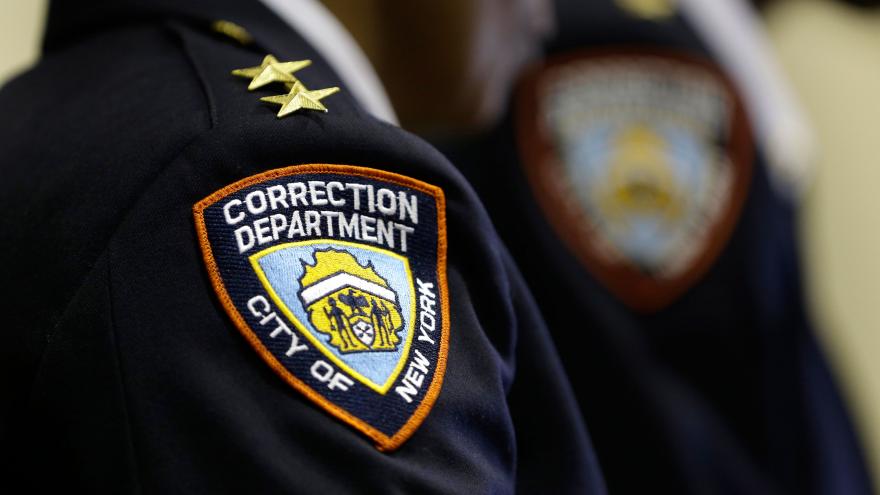
Four Rikers Island correctional officers were suspended for allegedly waiting several minutes to rescue an inmate who had tried to hang himself in a cell, authorities and law-enforcement sources said. Surveillance The video showed the officers stood by for seven minutes while a teenager attempted to hang himself. Video shows one officer even walked up to the holding pen where the teenager was hanging, opened the door, then closed the door and walked away without intervening. The city’s Department of Investigation opened an inquiry into the incident.
The guards — three correction officers and one captain — are accused of inaction during the near-fatal incident when Nicholas Feliciano, 18, allegedly attempted to hang himself at the George R. Vierno Center at about 12 a.m. on Nov. 28. The captain had witnessed the incident on surveillance footage and went to the inmate to cut him down, sources said. Feliciano was rushed to a nearby hospital in critical condition with no brain activity and remains in a medically induced coma. The 18-year-old had been jailed in Rikers since November 19th when he was arrested on a parole violation. Feliciano had been in an altercation at the jail earlier in the day of suicide attempt and had been moved from general population into a holding cell by himself.
Video footage of the suicide attempt described to the Times shows him wrap one end of a piece of clothing around his neck and another to a pipe on the ceiling of the cell. He then stepped off a wall that separates the toilet from the rest of the cell and hangs from his neck. At one point during the attempt, Feliciano appeared to have second thoughts and struggled to get his feet back on the wall. He hung from the pipe for about seven minutes before he was rescued. The area of the attempted suicide was in view of a guard desk where officers can monitor activity through video feeds. The actions of the officers were recorded by a separate camera.
Rikers Island has housed jail inmates since the 1930s and has long been known for brutality. The jail complex saw hundreds of stabbings every year during the 1980s and early 1990s. In 2014, an Associated Press investigation detailed dozens of inmate deaths including that of a homeless ex-Marine who essentially baked to death in a hot cell. In 2016, “60 Minutes” correspondent Bill Whitaker reported that a lack of adequate training and a rising mentally ill population have made an already bad situation in the jail worse. New York City lawmakers voted in October to close the Rikers Island jail complex, which has become synonymous with violence and neglect, and replace it with four smaller jails in separate boroughs by 2026. The plan has been met with pushback from communities where the new jails would be located.
Read more

In recent years, it’s become evident that oil giant Exxon was aware of the causes and consequences of climate change from at least the 1970s, but chose to deliberately mislead the public for decades. A newly resurfaced article now shows coal industry executives equally understood the science of catastrophic global warming as far back as 1966. According to a copy of the magazine Mining Congress Journal, leaders of the coal industry knew as early as the mid-1960s that burning fossil fuels causes climate change.
The head of a now defunct mining research company wrote that the combustion of fossil fuels was increasing carbon dioxide in the atmosphere, causing global temperature increases. The recently discovered article now provides evidence that both the coal and oil industries have known about catastrophic climate change for decades, yet worked to cover up the evidence in order to continue burning fossil fuels.
James Garvey, the then-president of Bituminous Coal Research Inc., which developed pollution control equipment, discussed the state of pollutants and their regulation in the coal industry at the time. While much of the paper is concerned with sulphur in coal, a small section early in the article is concerned with carbon dioxide (CO2) discharge. “There is evidence that the amount of carbon dioxide in the Earth’s atmosphere is increasing rapidly as a result of the combustion of fossil fuels,” Garvey writes.
“If the future rate of increase continues as it is at the present, it has been predicted that, because the CO2 envelope reduces radiation, the temperature of the Earth’s atmosphere will increase and that vast changes in the climates of the Earth will result. Such changes in temperature will cause melting of the polar icecaps, which, in turn, would result in the inundation of many coastal cities, including New York and London.”
Garvey’s article isn’t the only one acknowledging the dangers of coal-produced pollution in the August 1966 issue. In a discussion piece following Garvey’s paper, combustion engineer James Jones from Peabody Coal (now called Peabody Energy, the largest private coal company in the world), does not address the global warming issue, but admits that air pollution standards to protect health have a place, saying the “Situation is Urgent”.
Jones wrote “We are in favor of cleaning up our air. We are, in effect, ‘buying time’. But we must use that time productively to find answers to the many unsolved problems.” In the decades to come, Peabody would become a huge industrial player in organized climate change denial. At the end of his article, Jones wondered: “What can an individual with a personal stake in the future of the coal industry do?” Among the answers he offered, “Be a ‘one-man’ public relations emissary for the coal industry,” Jones explained to his industry colleagues. “Tell your neighbours, friends, and the general public how important coal is to their every-day existence. Also tell them about the all-out cooperative efforts of the coal industry to reduce air pollution.”
The concerted effort to discredit the scientific consensus over man-made global warming has been continuing for two decades in the United States and shows no sign of weakening. It is often described as an attempt on the part of corporate America, most notably the fossil fuel industries, to hinder governmental regulations on their activities.
Read more

Lung injuries and deaths linked to the use of e-cigarettes and vaping products has continued to rise in the US. The CDC has confirmed 2,290 vaping related lung injury cases and 47 deaths reported as of November 21st, 2019. Cases have been reported in all states except Alaska, along with the District of Columbia and two U.S. territories. Deaths have been confirmed in 25 states and Washington D.C., with more being investigated. Those affected by these illnesses range in age from 13 to 75 years old.
CDC data shows on 514 patients, about 77% reported using THC-containing products in the 30 days prior to the start of their symptoms. However, 16% reported using only nicotine-containing products. The illness is marked by chest pain, shortness of breath and vomiting, and it has largely affected young people. The vast majority of cases, almost 80%, involve e-cigarette users younger than 35, and another 15% are younger than 18.
While the investigation into the cause is still ongoing, the CDC has uncovered a potential cause- vitamin E acetate. Samples taken from the lungs of 29 people with e-cigarette, or vaping, product use associated lung injury or (EVALI) all contained vitamin E acetate. The CDC has also expanded its laboratory testing to include lung fluid, blood, and urine samples from patients, as well as lung biopsy and autopsy specimens.
Vitamin E acetate is commonly used in ingested supplements or skin care, and in those cases appears to be safe. Dr. Anne Schuchat, principal deputy director of the CDC said previous research has found that when vitamin E acetate is inhaled, it may interfere with normal lung function. She said they are no longer seeing such a dramatic rise in EVALI cases as earlier this fall but that some states are still investigating potential cases.
The agency continues to work with the Food and Drug Administration (FDA), states, and health providers to track and investigate this outbreak. The agency is also testing the vapor of e-cigarette products that have been involved in these cases to look for potentially harmful compounds. While it appears that vitamin E acetate is associated with EVALI, evidence is not yet sufficient to rule out contribution of other chemicals of concern to EVALI. Many different substances and product sources are still under investigation, and it may be that there is more than one cause of this outbreak.
EVALI looks and sounds like pneumonia. Symptoms include chest pain, shortness of breath, fever, nausea and vomiting. But it’s not an infection. The antibiotics used to clear up pneumonia don’t help the vaping illness and without knowing if a patient vapes-doctors might pursue the wrong treatment or miss the chance to encourage the person to stop. The CDC reports that some early patients with the illness who have been out of the hospital for several weeks have begun receiving follow-up care. Doctors are reporting that patients’ recoveries have varied, with some patients appearing to make full recoveries and others continuing to have trouble breathing. CDC reported that some patients have relapsed and had to be hospitalized a second time, with readmissions occurring from as few as five days to as many as 55 days after initial discharge.
E-cigarette manufacturers have advertised their products as a better option for adult smokers who are already hooked on nicotine. For thousands of young people who have never smoked, however, vaping plays the opposite role: It establishes a nicotine addiction that will ultimately lead to cigarette smoking.
Read more
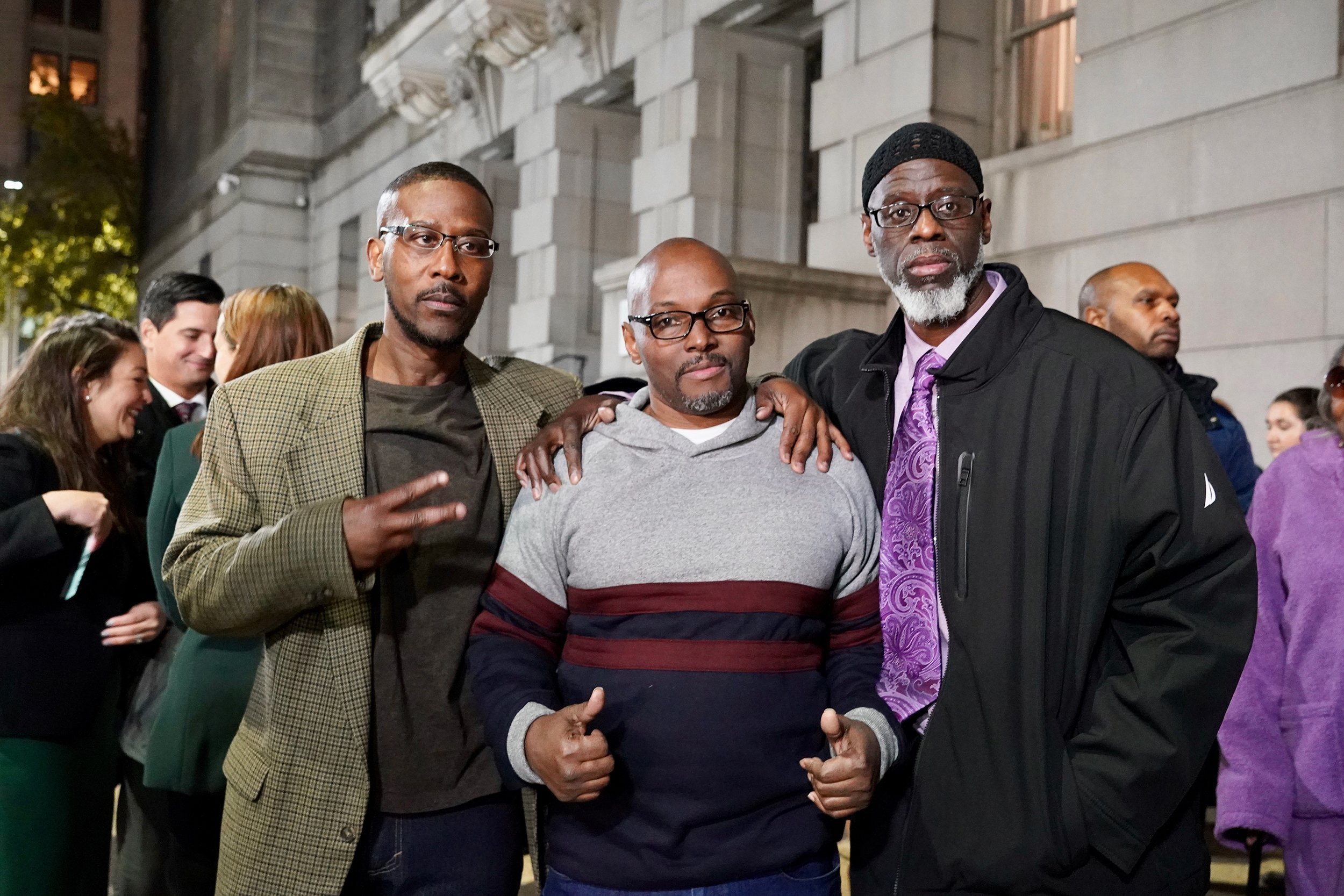
Three Baltimore men who spent 36 years in prison were released after authorities say they were falsely convicted of a 1983 murder. Alfred Chestnut, Ransom Watkins and Andrew Stewart were granted a writ of innocence after being convicted of first-degree murder of a middle school student, DeWitt Duckett. According to police, Duckett, 14, was shot and killed for his coveted Georgetown University basketball jacket in November 1983.
Chestnut has maintained his innocence since his arrest and the parole board denied his early release in part because he refused to admit responsibility for the shooting, the state’s attorney said. After he filed an information request this past spring, he discovered new evidence that was kept from his attorneys during trial. He reached out to Baltimore’s Conviction Integrity Unit, which was reviewing old convictions.
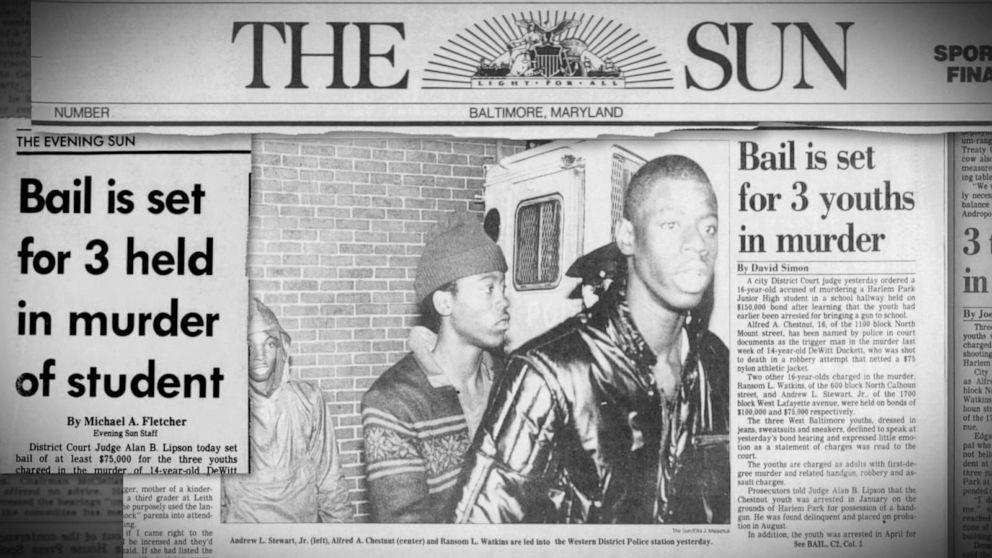
Chestnut and Watkins were 16 at the time of their arrest and Stewart was 17. The three teenagers had been skipping high school classes to visit former teachers at Harlem Park Junior High. Their teachers said they were being “silly,” but not threatening. School security escorted them off campus about half an hour before the murder occurred, according to a joint petition filed by the men and Baltimore City State’s Attorney Marilyn Mosby.
Watkins lawyer said the three teenagers were each arrested Thanksgiving morning, waking up with police with guns drawn on them. They were convicted based on witness testimony and what prosecutors at the time said was a crucial piece of evidence — a Georgetown jacket found in Chestnut’s bedroom. Chestnut’s jacket had no blood or gunshot residue and his mother was able to produce a receipt. A store clerk also testified that she had purchased it recently, the joint petition said.
Lawyers involved in the case said they were “horrified” to see the amount of exculpatory evidence that was hidden from the defense team and jury. Both the suspects and trial witnesses, all minors, were interrogated by police without their parents. Potential witnesses were interviewed in a group and told to “get their story together,” according to Chestnut’s lawyers. Anonymous calls identifying another shooter were kept from the defense, Mosby said. That teenager was seen after the shooting wearing what appeared to be Duckett’s jacket and confessing to the murder, she said. That suspect has since died and all trial witnesses have since recanted. “We have intentional concealment and misrepresentation of the exculpatory evidence, evidence that would have showed that it was someone else other than these defendants,” Mosby said.
Mosby apologized to the men “I don’t think that today is a victory, it’s a tragedy. And we need to own up to our responsibility for it,” Mosby said. “There’s no way we can repair the damage to these men, when 36 years of their life were stolen from them. You were all arrested on Thanksgiving 1983. Now you are free to spend the holidays with your loved ones for the first time in 36 years,” Mosby said in a press conference. The men are now in their early fifties preparing to enter adulthood on the outside for the first time and at least two have never driven a car before. Now, late in life, they will experience a world very different from the one they were barred from since their teens.
Read more
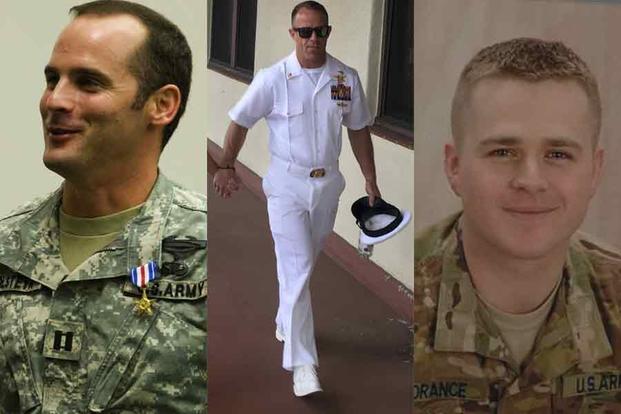
The administration has granted clemency to three controversial military figures embroiled in charges of war crimes, arguing the moves will give troops “the confidence to fight” without worrying about potential legal overreach. Army 1st Lt. Clint Lorance, convicted of 2nd degree murder in the death of two Afghans, was given a full pardon. Army Maj. Mathew Golsteyn, who faced murder charges for a similar crime, was also given a full pardon for those alleged offenses. Special Warfare Operator Chief Edward Gallagher, who earlier this year was acquitted of a string of alleged war crimes, had his rank restored to Chief Petty Officer.
Critics have warned the pardons could send the message that troops need not worry about following rules of engagement when fighting enemies abroad. Lorance’s case dates back to a 2012 deployment to Afghanistan, when he ordered his soldiers to fire on three unarmed men riding a motorcycle near their patrol. Members of his platoon testified against him at a court-martial trial, describing him as over-zealous and the Afghans as posing no real threat. He was sentenced to 19 years in prison at Fort Leavenworth, Kansas.
Golsteyn’s case had not yet been decided, with a scheduled trial date in December on charges he murdered an alleged Taliban bomb maker, and burned his remains in a trash pit during a 2010 deployment with 3rd Special Forces Group. Golsteyn, an Army Green Beret major, had pled not guilty to murder and related charges. His pardon effectively puts an end to that legal case before any verdicts were rendered.
While Gallagher was acquitted of murder and obstruction of justice charges in July, a panel of his peers recommended he be reduced in grade for posing with the body of the teenaged detainee, a crime he never denied. His rank was restored with the pardon but the Navy plans to remove Chief Gallagher from the elite SEAL team despite the pardon. It’s been reported that several top military officials threatened to resign if Navy officials did not move forward with these plans despite the pardon.
Chief Gallagher was accused of multiple offenses during his final deployment to Iraq and during the Battle for Mosul. The most prominent and disturbing accusation was the murder of a prisoner of war, a war crime. A captured young ISIS fighter was being treated by a medic. According to two SEAL witnesses, Gallagher said over the radio “he’s mine” and walked up to the medic and prisoner. Without saying a word to the medic or prisoner, Gallagher killed the prisoner by stabbing him repeatedly with his hunting knife. Gallagher and his commanding officer, Lieutenant Jake Portier, then posed for photographs of them standing over the body with some other nearby SEALs. Gallagher then text messaged a fellow SEAL a picture of the dead captive with the explanation “Good story behind this, got him with my hunting knife.”
Gallagher was also accused of being indiscriminate, reckless and bloodthirsty during his 2017 deployment. Fellow snipers did not consider him to be a good sniper because he would allegedly take random shots into buildings and indiscriminately spray neighborhoods with rockets and machine gun fire with no known enemy force in the region. Several snipers testified that they witnessed Gallagher taking at least two militarily pointless shots, shooting and killing an unarmed old man in a white robe as well as a young girl walking with other girls. Gallagher was allegedly known for boasting about the large number of people he had killed, claiming he averaged three kills a day over 80 days, including four women.
Read more
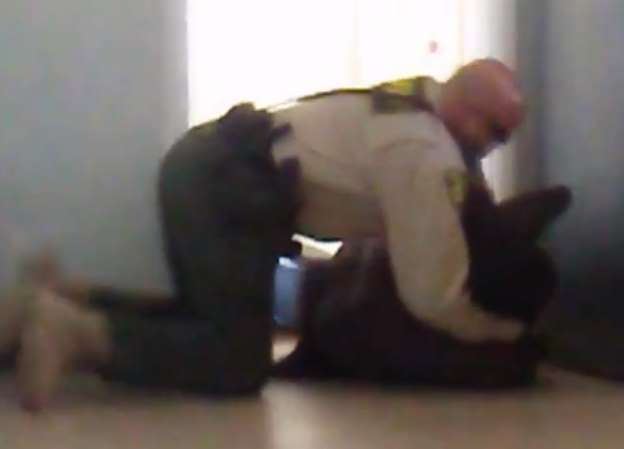
An Arizona sheriff’s deputy has been placed on administrative leave after disturbing cellphone video footage surfaced showing the deputy tackling and pinning a 15-year-old quadruple amputee to the ground. The incident sparked an internal affairs investigation by the Pima County Sheriff’s Department and a spokesman for the sheriff’s department said Deputy Manuel Van Santen was placed on leave pending the investigation.
The Sept. 26 incident started when the 15-year-old, who was in a group home after being abandoned by his family, allegedly knocked over a garbage can and verbally threatened a worker. Van Santen was called to the group home to restore order. In the video, Van Santen is seen holding the boy down for more than a minute as the teen struggles to break free. The deputy is shown in the video kneeling next to the amputee and putting the teen in a headlock. The teen can be heard becoming more upset, asking the deputy not to hold him down.
When Van Santen loosened his grip, the boy attempted to break free but did not get far before the deputy tackled him, wrapping his arms around the teen to subdue him. Eventually, the boy stops protesting and the officer lets him get up, asking him what his problem is, and why he kept moving when he was told not to move. As the 15-year-old insists he doesn’t have a problem and only threw a trash can, the deputy gets louder, bending over so that his face is inches away from the teenager’s as he yells and swears at him.
The teen recording says to the deputy, “Hey, you asked him a question, and he answered,” he tells the deputy. “Shut the hell up!” the deputy snaps back. He orders the teen out of the room and the boy responds that he can’t eat his cereal in his room. The deputy storms over, screaming at him to stay out of something that doesn’t involve him. “You shut the hell up!” he yells again. Both teens were arrested on disorderly conduct charges but Arizona prosecutors dropped disorderly conduct charges against the quadruple amputee.
Pima County public defender Joel Feinman said the incident likely would not have come to light if it had not been recorded by another teen living in the home since Van Santen was not wearing a body camera. It is not clear how long the incident lasted, as the 8 minute video began in the middle of the struggle. Feinman said the 16-year-old boy who recorded the incident had his head pushed into a wall by deputies during the incident. “These are kids who have already been traumatized in some way,” Feinman, whose office is representing both boys. “Men with badges should not be acting this way,” Feinman told the television station. “Men and women who do act this way should not have badges and guns.”
Feinman stated that given that Immanuel has no legs and is missing most of his arms — and wasn’t even wearing a shirt, making it unlikely that he could have somehow been hiding a concealed weapon –it is hard to fathom that he posed a threat to “this very large policeman with a badge and a gun.” Regardless of what the teenager said to the officer, he argues, the better response would have been to sit down and try to de-escalate the situation.

Read more

Two Manhattan federal jail guards accused of trying to cover up their failure to check on Jeffrey Epstein in the hours before his suicide are scheduled to go on trial April 20. Tova Noel and Michael Thomas were charged in U.S. District Court with conspiracy and falsifying official records. Prosecutors say they have hundreds of hours of video which shows the two guards were were sleeping, shopping online for furniture and catching up on sports news instead of checking on Epstein and other prisoners every 30 minutes.
Prosecutors said the guards appeared to have slept, surfed the internet, moved around a common area and sat at their desk instead of doing mandated inmate head counts and regular rounds in the special protective unit of the jail, where Epstein was being held awaiting trial. Prosecutors say some of the video does not show anyone approaching Epstein’s cell after he was last seen entering it on the night of Aug. 9. He was found unresponsive in the early morning hours of Aug. 10th.
The indictments against them say the two guards then falsified prison records to claim they had performed their required rounds. The guards have been charged with conspiracy to defraud the United States and with making false records. “We allege these officers falsified records to create the appearance they were following… protocols. The security risks created by this type of behaviour are immense,” FBI assistant director William Sweeney said in the statement.
US Attorney General William Barr ordered their suspension in August after the FBI opened an investigation. Federal prosecutors later offered the guards a plea bargain but they turned it down. “As a result of their false statements,” prosecutors say, “the MCC believed prisoners in the SHU were being regularly monitored when, in fact, as a result of the defendants’ conduct, no correctional officer conducted any count or round of the SHU from approximately 10:30 p.m. on August 9 until approximately 6:30 a.m. on August 10, at which time, Noel and Thomas discovered the body of MCC inmate Jeffrey Epstein, who had committed suicide overnight while unobserved.”
The Attorney’s Office says Noel, 31, and Thomas, 41, have each been charged with “one count of conspiring to defraud the United States by impairing, obstructing, and defeating the lawful functions of the MCC, and to make false records, which carries a maximum sentence of five years in prison. Noel is also charged with five counts of making false records, and Thomas is also charged with three counts of making false records, each of which carries a maximum sentence of five years in prison.
New York City’s medical examiner ruled that the convicted sex offender took his own life inside his Manhattan federal prison cell on Aug. 10, but a pioneering forensic pathologist told Fox News in late October that Epstein’s body bore telltale signs of homicide. Prosecutors wrote in the indictment that no one appeared to enter the area where Epstein was being held in the hours before he was found dead. “As reflected on video obtained from the MCC’S internal video surveillance system, at approximately 10:30 p.m. on August 9, 2019… Noel briefly walked up to, and then walked back from, the door to the tier in which Epstein was housed,” it said. “As confirmed by the video… this was the last time anyone, including any correctional officer, walked up to, let alone entered, the only entrance to the tier in which Epstein was housed until approximately 6:30 a.m. on August 10.”
Read more













